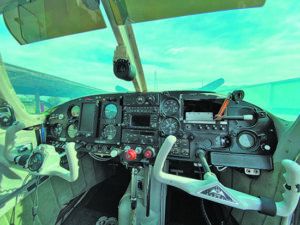For this month’s panel planner, we’re looking at a big-screen glass makeover on a 1965 Mooney M20E. An old gal that came off the Kerrville, Texas, line nearly 60 years ago, it may be worth the big investment because the airframe and engine have low times, and owner Donald Beirdneau and his partner plan to fly it hard IFR. After demoing the gear at Garmin’s tent at AirVenture last summer, the partners are sold on Garmin’s latest glass—lots of it. Let’s noodle the project.
GUT IT OUT, CLEAN IT UP
The avionics have already been worked over, sporting an Aspen flight display, Garmin GNS 430 and a GTX 327 digital transponder, not shown in the picture below. But all of it—including the engine and fuel gauges, Mooney vacuum-driven wing-leveling autopilot and the Narco MK12D navcomm—are coming out. The Aspen, GNS 430 and transponder might fetch $10,000 on the used market.

Since the plan includes a Garmin G3X Touch suite, to include a 10.6-inch PFD on the pilot’s panel and a 7-inch display on the right (which will display Garmin’s EIS engine and fuel data), the Mooney will get new instrument panel overlays. One good source for a custom build that comes to mind for this work is Superior Aircraft Components in Texas. They can turn it quickly and offer a wide range of graphics and styling, plus they’ll finish it with the required placards.
Now is also the time to rework the electrical bus, modernizing the fuses and circuit breakers and cleaning up any old wiring. The vacuum system can come out, since the Garmin suite’s AML-STC says it’s fair game. That’ll save weight and greatly reduce clutter behind the panel.
IN WITH THE NEW
One major system in this retrofit is Garmin’s GFC 500 autopilot, and the mode controller will fit nicely at the top of the radio stack where the old one was. For backing up the G3X Touch flight display, the plan is to use Garmin’s GI 275 AI/ADI, which should fit nicely on the new pilot’s panel where the current altimeter lives. It has an interconnect with the GFC 500 for pitch/roll signal failsafe, and displays autopilot mode annunciation.
Since another major system in the suite is Garmin’s EIS (an approved replacement for all of the OEM engine and fuel gauges), now is a good time to either overhaul the existing fuel quantity senders or consider replacing them with CIES digital senders, which are STC’d for the M20 series, and they’re compatible with the Garmin suite. The second G3X Touch on the right panel will come in handy for displaying all the EIS data, plus it will display on the primary G3X Touch screen.
Over in the main stack, Garmin’s GNX 375 GPS WAAS navigator has a built-in ADS-B Out and In transponder, plus it has the Flight Stream wireless module. That means the ADS-B and flight plan data can talk back and forth to a tablet running Garmin Pilot or ForeFlight. To back up the GNX 375, we would consider Trig’s new TX56 navcomm, which has a VHF nav receiver for shooting a ground-based ILS in case of a GPS outage. It works with the G3X Touch, too. Garmin’s GMA 245R Bluetooth audio panel has G3X Touch onscreen control.
IT COSTS HOW MUCH?
Doing some back-of-the-napkin math, the bulk of the equipment has an eye-watering list price north of $46,000. Add in a new panel, fuel senders, a panel USB port, CO detector and replacing older antennas and plan on $55,000 worth of gear. With labor, this could easily be a $75,000 project.
Another option is to do the upgrade in stages, but given the level of teardown (plus the custom panel build), we think it makes sense to hit it all at once. In the end, this airplane will sit at the very top of the vintage Mooney food chain, and serve as one heck of a capable IFR machine.


